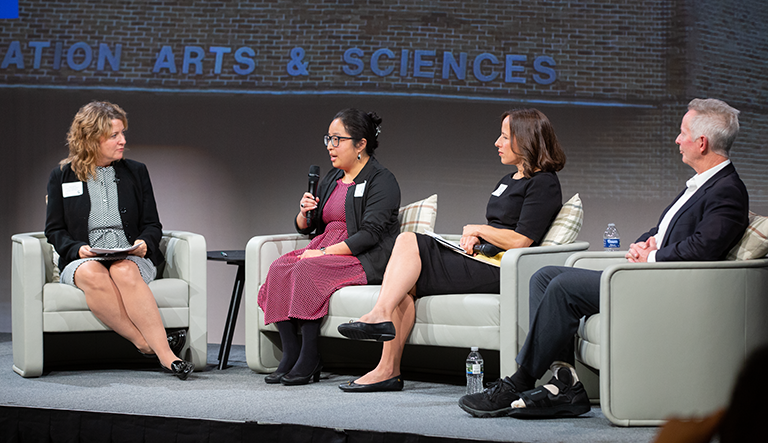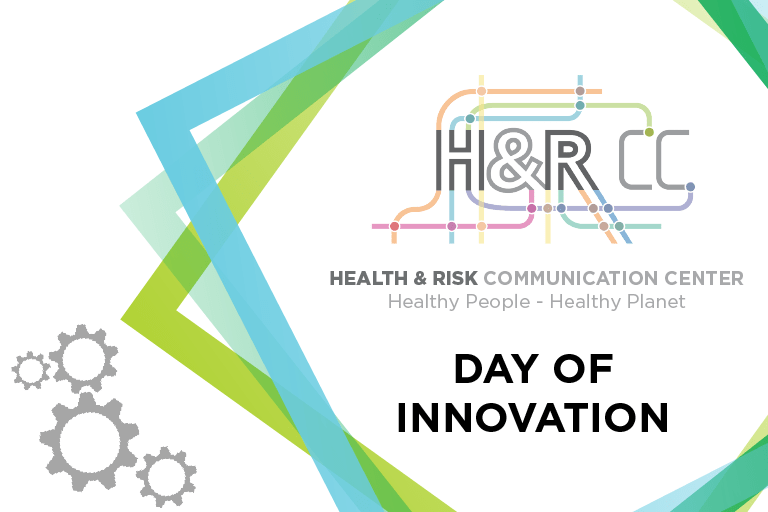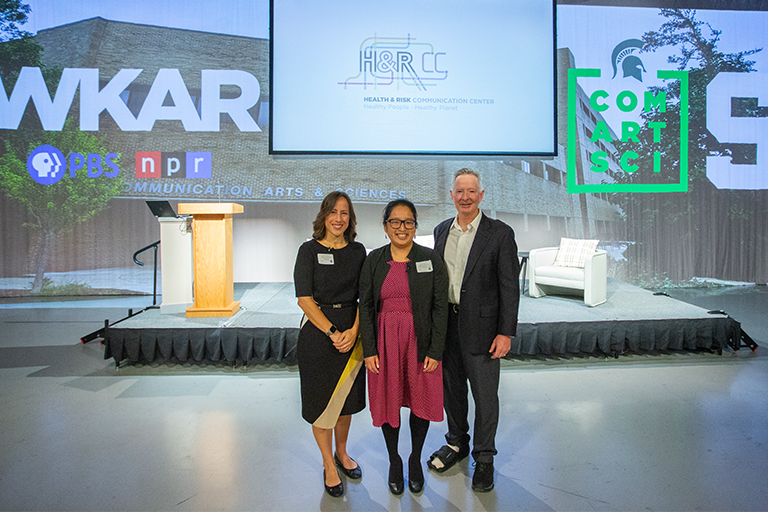Michigan State University’s Health and Risk Communication Center (HRCC) hosted a panel of professionals and scholars to discuss the field’s latest trends and insights at the third annual Day of Innovation, Nov. 3, 2023, at the College of Communication Arts and Sciences.
Innovation and Insights in Health and Risk Communication
When it comes to communication strategies for risk reduction and healthy behaviors, MSU’s HRCC is at the top of its game. It’s not only because HRCC’s faculty are world renowned in health communication education or that the research portfolio is consistently ranked as one of the top, it also has a lot to do with the ways the center engages other organizations, professionals, and the public in the overall conversation.
“These events are for our alumni, current students, faculty, our community partners and friends around the Greater Michigan area to inspire them to be excited about things that are going on in health, risk, environment and science communication,” said Professor and Director of the HRCC, Maria Lapinski.
That’s the essence of the Day of Innovation — an event Lapinski and her team have facilitated since 2019, providing invigorating panel discussions and ample networking for those interested in healthy people and a healthy planet.
This year’s panelists were Laura M. Kollar, Senior Health Scientist at the CDC; Amanda Lick, Director of Community Health Solutions with Emergent BioSolutions; and Brandt Endowed Professor at ComArtSci, Jim Dearing.
Dearing was excited to share details of his ongoing project, which began this summer, with the US Centers for Disease Control and Prevention. “It’s a large-scale test of what we think we can do with diffusion of innovation theory to help achieve a CDC objective of saving people’s lives,” Dearing said.
Lapinski was pleased to see that attendees were excited to gather again and learn something new. An unintentional ‘theme’ was also developed. “What I love about all the talks is that they really kind of kept going back to this kind of communication process-focused way of thinking about how to do communication research and practice,” she said. “And then Jim Dearing, who was the final speaker, kind of brought it all home and wrapped it all up in a bow.”

Photo: (left to right) Maria Lapinski, Laura Kollar, Amanda Lick and Jim Dearing.
“When researchers and practitioners — including students — work together on projects, the results can bring out the best of both types of work,” said Jim Dearing of the 2023 Day of Innovation.
The Case of Drug Overdose Prevention Communication
Following the panel, the trio reflected on their conversation.
“All three of us presented our work as it relates to drug overdose prevention, and that was just fortuitous. We hadn’t planned to all talk about drug overdose prevention,” Dearing said. “Moreover, the three presentations were complementary — they fit well together.”
The subject is deeply personal for Lick, who lost her mother in 2007 to an overdose. “I spent my life being silent about my mom’s addiction and the impact it had on our family,” Lick said. “It was through learning that it was important to communicate, and through the education that I got, that I realized silence and stigma is what continues to let people die of an overdose.”
Innovative community health solutions are crucial to saving lives. Lick praised initiatives like the partnership between the Chicago Department of Public Health (CDPH) and the Chicago Public Library (CPL), in which librarians have been trained on opioid overdose prevention and equipped with naloxone — an opioid antagonist that can reverse and block the effects of other opioids.
“Naloxone is often given at a hospital or a sheriff’s department,” Lick explained. “Libraries are now a big part of how communities can get naloxone in the hands of people that need it.”
Kollar — who works with underrepresented communities as a health equity officer in the division of overdose prevention, and champions CDC’s Drug Free Communities program — agrees.
“Communities can work together by using best practices; sometimes those look different than we imagine,” Kollar said. “Medication, other forms of harm reduction, educating people about how to get to naloxone, how to use naloxone … the CDC has great resources for that.”
Education With Impact
While both Kollar and Lick are proud alumnae of the Health and Risk Communication Master’s program, Lapinski was pleasantly surprised to find the HRC M.A. receiving unprompted kudos from the stage.
“I know that it's a great program, but it was just great to hear from other people,” she said. “I felt like I had to turn around and say, ‘I didn’t tell them to say this!’”
But Kollar finds her MSU education was critical to her success. “The health communication degree is very transferable and needed in our workplaces these days. I use my communication skills every day,” she explained. “Not necessarily that we need to follow this perfect theory, sometimes it’s just infused in how I’m having conversations, practicing listening skills, cross-cultural communication skills … It’s important for me to understand that how I talk and speak is different from how others speak — and emphasize the importance of in-person communication to build and strengthen relationships.”
Lick agrees. “When we continue to see miscommunication out there, health and risk communication people can step in and provide the plain language to those that need to know,” she said. “We all have it within us — almost like a pilot light, a little fire within us that motivates us to do the things we do… use that ‘why’ to make a difference in the world.”
—Jessica Mussell
More Day of Innovation:
2019 College Hosts Health & Risk Communication: Day of Innovation
2021 HRCC presents second annual Day of Innovation: Features Bettinghaus Endowed Lecture
More Health and Risk Communication:
Health and Risk Communication Center (HRCC)

